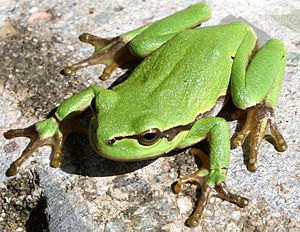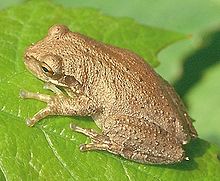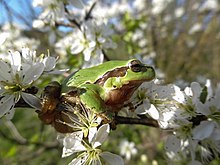Tree frogs (family)
| Tree frogs iw S. | ||||||||||||
|---|---|---|---|---|---|---|---|---|---|---|---|---|

European tree frog ( Hyla arborea ) |
||||||||||||
| Systematics | ||||||||||||
|
||||||||||||
| Scientific name | ||||||||||||
| Hylidae | ||||||||||||
| Rafinesque , 1815 |
The family of the tree frogs (Hylidae) consists mainly of climbing frogs (Anura), whose species are distributed worldwide. They achieve the greatest diversity in the New World . About 720 species are currently known, making it one of the most species-rich families in the amphibian class .
Characteristics, behavior
There is a great abundance of forms; It is not easy to name common characteristics (for bone structure compare: Neobatrachia ). Tree frogs in the broader sense usually have smooth skin, quite long jump legs and live mainly on bushes, trees and other plants. Thanks to their characteristic adhesive discs on the finger and toe ends, they can climb very well. This behavior is also supported by an intermediate cartilage in front of the end members of the fingers, which enables them to grasp movements.
For spawning , most species seek out small ponds or other pools of water at night and often deposit very small lumps of eggs in the water; But there are also different forms of spawning on leaves (compare, for example, maci frogs , red- eyed tree frogs ) and brood care. Often the males have a large fillet constant vocal sac produce with which it loud mating calls. In the amplexus, they cling the females immediately behind the front legs.
distribution
A particularly large number of representatives of this family inhabit the tropical rainforests of the world, especially in Latin America . Specifically, tree frogs occur in North and South America, on the Caribbean islands, in Australia and New Guinea, with a few species in the temperate zones of Eurasia (from Europe to the Japanese archipelago) and with only one species, the Mediterranean tree frog , on the northwestern edge of Africa . (In most of Africa there is no family; instead, the row frogs and reed frogs , which look very similar, are found here .) On Pacific islands such as New Caledonia , Vanuatu , Guam and New Zealand , individual tree frog species were introduced by humans.
Taxonomy



The systematic composition of the tree frog family is controversial. Depending on whether molecular biological or morphological comparison features are in the foreground, different authors suggest strongly deviating overviews. The most comprehensive revision of the last few years resulted in an abundance of rearrangements and new names. Among other things, the previous subfamily Hemiphractinae has been completely spun off and is now treated as a separate family Hemiphractidae , as well as the two former subfamilies Griffin frogs (Phyllomedusinae) and Australian tree frogs (Pelodryadinae) were raised to family status in 2016 . The two new families Phyllomedusidae and Pelodryadidae were combined with the remaining tree frogs in the original family (former subfamily Hylinae ) to form the group of Arboranae . Furthermore, many new genera were established and species within the genera were reassigned. So in the formerly most extensive genus Hyla , which was the only Central European member of the family, the European tree frog , only 17 species remained. The overview presented here also does not represent a conclusive “finished” system of the Hylidae family.
(Processing status: 2019)
- Subfamily Acridinae
Mivart , 1869
- Genus Acris Duméril & Bibron , 1841
- Genus Pseudacris Fitzinger , 1843
- Subfamily Cophomantinae Duellman , Marion & Hedges , 2016
- "Hyla" nicefori ( Cochran & Goin , 1970)
- Genus Aplastodiscus Lutz , 1950
- Genus Boana Gray , 1825 (including genus Hypsiboas Wagler , 1830)
- Genus Bokermannohyla Faivovich , Haddad , Garcia , Frost , Campbell & Wheeler , 2005
- Genus Hyloscirtus Peters , 1882
- Genus Myersiohyla Faivovich , Haddad , Garcia , Frost , Campbell & Wheeler , 2005
- Genus Nesorohyla Pinheiro , Kok , Noonan , Means , Haddad & Faivovich , 2018
- Subfamily Dendropsophinae Fitzinger , 1843
- Genus Dendropsophus Fitzinger , 1843
- Dendropsophus leucophyllatus ( Beireis , 1783)
- Genus Xenohyla Izecksohn , 1998
- Genus Dendropsophus Fitzinger , 1843
- Subfamily Hylinae Rafinesque , 1815
- Genus Atlantihyla Faivovich , Pereyra , Luna , Hertz , Blotto , Vásquez-Almazán , McCranie , Sánchez , Baêta , Araujo-Vieira , Köhler , Kubicki , Campbell , Frost , Wheeler & Haddad , 2018
- Genus Bromeliohyla Faivovich , Haddad , Garcia , Frost , Campbell & Wheeler , 2005
- Genus Charadrahyla Faivovich , Haddad , Garcia , Frost , Campbell & Wheeler , 2005
- Genus Dryophytes Fitzinger , 1843
- Genus Duellmanohyla Campbell & Smith , 1992
- Genus Ecnomiohyla Faivovich , Haddad , Garcia , Frost , Campbell & Wheeler , 2005 - see e.g. B. Ecnomiohyla rabborum
- Genus Exerodonta Brocchi , 1879
- Genus Hyla Laurenti , 1768 - tree frogs
- Genus Isthmohyla Faivovich , Haddad , Garcia , Frost , Campbell & Wheeler , 2005
- Genus Megastomatohyla Faivovich , Haddad , Garcia , Frost , Campbell & Wheeler , 2005
- Genus Plectrohyla Brocchi , 1877
- Genus Ptychohyla Taylor , 1944
- Genus Quilticohyla Faivovich , Pereyra , Luna , Hertz , Blotto , Vásquez-Almazán , McCranie , Sánchez , Baêta , Araujo-Vieira , Köhler , Kubicki , Campbell , Frost , Wheeler & Haddad , 2018 (4 sp.)
- Genus Rheohyl Duellman , Marion & Hedges , 2016 (1 sp.)
- Genus Sarcohyla Duellman , Marion & Hedges , 2016 (24 sp.)
- Genus Smilisca Cope , 1865 - see e.g. B. Costa Rican tree frog
- Genus Tlalohyla Faivovich , Haddad , Garcia , Frost , Campbell & Wheeler , 2005
- Genus Triprion Cope , 1866 including crowned tree frog
- Subfamily Lophyohylinae Miranda-Ribeiro , 1926
- Genus Aparasphenodon Miranda-Ribeiro , 1920
- Genus Argenteohyla Trueb , 1970
- Genus Corythomantis Boulenger , 1896
- Genus Dryaderces Jungfer , Faivovich , Padial , Castroviejo-Fisher , Lyra , Berneck , Iglesias , Kok , MacCulloch , Rodrigues , Verdade , Torres-Gastello , Chaparro , Valdujo , Reichle , Moravec , Gvoždík , Gagliardi-Urrutia , Ernst , De la Riva , Means , Lima , Señaris , Wheeler & Haddad , 2013 (2 types)
- Genus Itapotihyla Faivovich , Haddad , Garcia , Frost , Campbell & Wheeler , 2005
- Genus Nyctimantis Boulenger , 1882
- Genus Osteocephalus Steindachner , 1862
- Genus Osteopilus Fitzinger , 1843 - see e.g. B. Cuban tree frog
- Genus Phyllodytes Wagler , 1830
- Genus Phytotriades Jowers , Downieb & Cohen , 2009 (1 species)
- Genus Tepuihyla Ayarzagüena , Señaris & Gorzula , 1993
- Genus Trachycephalus Tschudi , 1838 - poisonous tree frogs (also: toad tree frogs)
- Subfamily Pseudinae Fitzinger , 1843
- Genus Lysapsus Cope , 1862
- Genus Podonectes Steindachner , 1864
- Genus Pseudis Wagler , 1830 - see e.g. B. Pseudis paradoxa
- Genus Scarthyla Duellman & de Sá , 1988
- Subfamily Scinaxinae Duellman , Marion & Hedges , 2016
- "Hyla" antoniiochoai De la Riva & Chaparro , 2005
- "Hyla" helenae Ruthven , 1919
- "Hyla" imitator ( Barbour & Dunn , 1921)
- "Hyla" inframaculata Boulenger , 1882
- "Hyla" Warreni Duellman & Hoogmoed , 1992
Individual evidence
- ↑ American Museum of Natural History (AMNH): Amphibian Species of the World - Hylidae - Distribution
- ↑ J. Faivovich, CFB Haddad, PCA Garcia, DR Frost, JA Campbell & WC Wheeler: Systematic Review of the Frog Family Hylidae, with special Reference to Hylinae: Phylogenetic Analysis and Taxonomic Revision. Bulletin of the American Museum of Natural History, 294: 240 p., New York 2005 ( PDF online version )
- ^ William E. Duellman, Angela B. Marion & S. Blair Hedges: Phylogenetics, classification, and biogeography of the treefrogs (Amphibia: Anura: Arboranae). Zootaxa 4104, 1, pp. 1–109, April 2016.
- ↑ This is based on: Amphibiaweb.org including the American Museum of Natural History (AMNH): Amphibian Species of the World - Hylidae
- ↑ This genre is taken by other authors as a synonym of pseudis ; see: American Museum of Natural History (AMNH): Amphibian Species of the World - Lysapsus
- ↑ Species of this genus are assigned to the genus Pseudis by other authors ; see: American Museum of Natural History (AMNH): Amphibian Species of the World - Podonectes
- ↑ This genus is assigned to a separate family Pseudidae by other authors

